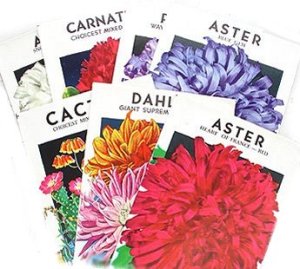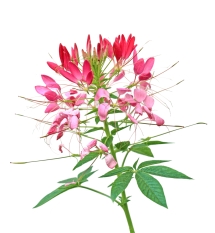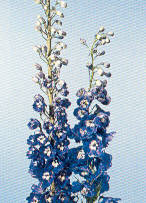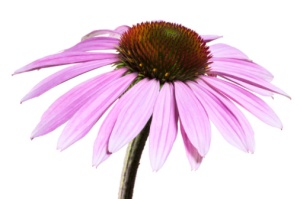Here we are, in mid-March again. Those dozens of seed catalogs are in and it seems that you can’t go anywhere without running into racks of Ferry Morse or Burpee seeds, to mention but two of the many seed companies. And then there are all of those packaged bulbs and dried out perennials that we see.
The choices for startin g are unreal. Along these lines, we have a garden 24 x 100 feet where an old greenhouse stood and I have decided to grow some summer flowers for the shop. As I began putting a plan on paper, I was faced with a lot of questions about choices. Would I grow perennials? If I went the seed route it would take two years before any substantial crop. Or, I could buy plants in 4 or 6 inch pots and get some blooms this summer and then more next summer. Since I have decided to put everything in pots, winter storage could be a problem with perennials.
g are unreal. Along these lines, we have a garden 24 x 100 feet where an old greenhouse stood and I have decided to grow some summer flowers for the shop. As I began putting a plan on paper, I was faced with a lot of questions about choices. Would I grow perennials? If I went the seed route it would take two years before any substantial crop. Or, I could buy plants in 4 or 6 inch pots and get some blooms this summer and then more next summer. Since I have decided to put everything in pots, winter storage could be a problem with perennials.
I decided that I would go the “annual” root. I could start my seeds this week and see the first flowers around the first of July. Also, I could wait until the end of May and buy all the plants I needed at a garden center. I need about 400 plants for the project, so that would be cost prohibitive, especially since I have greenhouse space and some knowledge on the topic. So, I guess I will be sowing a lot of seeds – less than a hundred dollars versus three or four hundred for grown plants. So, for the past several weeks I have been poring over seed catalogs, trying to decide what I would work with. So far it has been an enjoyable adventure. I would encourage anyone to try.
But first  a few notes. As you look at the catalogs you will note that most of the seeds are classified as annual, perennial or biennial. Knowing the difference is very important. A perennial is a plant that survives, and thrives, for several years. I have always heard folks say that they would plant all perennials because you didn’t have to buy new plants every year. That is true, but the labor factor makes a big difference. There is more weeding, cleaning and being aware of diseases and pests. My favorite perennials are the Delphinium, Bleeding Hearts, Sedum and Poppies.
a few notes. As you look at the catalogs you will note that most of the seeds are classified as annual, perennial or biennial. Knowing the difference is very important. A perennial is a plant that survives, and thrives, for several years. I have always heard folks say that they would plant all perennials because you didn’t have to buy new plants every year. That is true, but the labor factor makes a big difference. There is more weeding, cleaning and being aware of diseases and pests. My favorite perennials are the Delphinium, Bleeding Hearts, Sedum and Poppies.
With annuals, they last only one season, you need to sow or buy each year. But  they are showier. While many perennials live a long time, most have a shorter flowering season. By carefully selecting varieties you can have flowers from late June right up until frost. Petunias and Impatiens are examples of annuals. For my cutting garden I have chosen taller types like Zinnias, Larkspur, and coneflowers. The choices are infinite. As an end note, biennials are plants like Sweet William and Foxglove that grow the first year and then flower profusely the second and begin to fade away on the third.
they are showier. While many perennials live a long time, most have a shorter flowering season. By carefully selecting varieties you can have flowers from late June right up until frost. Petunias and Impatiens are examples of annuals. For my cutting garden I have chosen taller types like Zinnias, Larkspur, and coneflowers. The choices are infinite. As an end note, biennials are plants like Sweet William and Foxglove that grow the first year and then flower profusely the second and begin to fade away on the third.
I think that once you have selected your seeds, the rest is easy.  Garden and home improvement stores now carry plastic trays, fitted with any number of slots in the base, each about an inch or more across. And in each slot there is a little round disk of compacted peat moss. And to make life even better, the trays are fitted with a clear plastic top. Voila – your own seed starting greenhouse. How easy can it get? When you are ready to sow, be sure that the disks are setting flat in each hole and fill the tray with water. In a very short time those disks will expand to fill the areas. You are now ready to plant. Depending on variety and size of seeds I like to place 2 or 3 on each disk. That way I can just pull them up and plant them in the garden without having to break them apart. With those tiny seeds, you will not have much control. You can just pick out and discard the smallest plants when you are ready for the garden. Water as needed and watch the magic happen.
Garden and home improvement stores now carry plastic trays, fitted with any number of slots in the base, each about an inch or more across. And in each slot there is a little round disk of compacted peat moss. And to make life even better, the trays are fitted with a clear plastic top. Voila – your own seed starting greenhouse. How easy can it get? When you are ready to sow, be sure that the disks are setting flat in each hole and fill the tray with water. In a very short time those disks will expand to fill the areas. You are now ready to plant. Depending on variety and size of seeds I like to place 2 or 3 on each disk. That way I can just pull them up and plant them in the garden without having to break them apart. With those tiny seeds, you will not have much control. You can just pick out and discard the smallest plants when you are ready for the garden. Water as needed and watch the magic happen.

